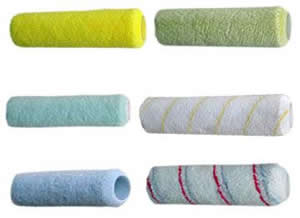The finished quality of any painting project is subject to three factors; the quality of the paint, the workmanship and the quality of the brushes and rollers, as shown in Figure 1. In this article we will discuss how to choose a paint roller that is best suited for your project.

Figure 1 - Assortment of paint rollers
When choosing paint rollers there are 3 considerations:
- Material or Fabric – what is the outer material or fabric, the material or fabric that will hold the paint and apply it to the surface, of the paint roller is made of?
- Core – what is the material used for the inner core of the paint roller?
- Nap – how long are the fibers on the paint roller?
Note: Choose your paint and then choose your application tools. Many paint manufacturers will recommend certain materials or fabrics and nap lengths for paint rollers as part of their application instructions. Always follow the manufacturer’s recommendations; believe it or not, they do know what the best method of applying their paint product is.
Material or Fabric:
You can choose from a wide variety of materials or fabrics.
Synthetic materials and fabrics can be used in almost all circumstances. However, there are some paint roller materials or fabrics that work best under certain circumstances:
- If you are using enamel paints and want a very smooth finish mohair is the best material for the painting project.
- Consider using a lamb’s wool paint roller if you are applying alkyd paints or oil based stains. Do not use lamb’s wool if you are applying latex based paints.
- If you are applying any two-part epoxy or fiberglass paint you must use a paint roller with a material or fabric and core that has been specially designed for these types of paints. Two-part paints are formulated with chemicals that will damage the run-of-the-mill paint rollers. Follow the coating manufacturer’s recommendations for the paint rollers.
Core:
The core material provides a surface to apply the fabric or material. Inexpensive rollers are made with cardboard cores. Cardboard cores will get soft, will not hold their round shape and when cleaned in water will deteriorate, making the paint roller all but useless. It is not uncommon to have pieces of nap come off a cardboard core as the paint is being applied. This is because the chemical solvents in the paint attack the adhesives use to bond the fabric or material to the cardboard core.
High quality paint rollers use a plastic core which will not be damaged by the paint, solvents or washing. As well, with a plastic core paint roller the material or fabric is bonded to the plastic core without the use of an adhesive. Hence, pieces of the nap will not fall off the core as the paint is being applied.
Nap:
The nap refers to the length of the fibers on the paint roller and the correct choose of nap length is crucial to obtaining a professional finish. The choice of nap length is determined by the level of smoothness of the surface to be painted.
The basic rule for nap length is; the smoother the surface to be painted the shorter the paint roller nap length to be used and in the reverse, the rougher the surface the longer the paint roller nap length to be used.
Chart 1 provides the recommended nap lengths for different surfaces.
Material |
Material |
||||||
Acoustical Tile |
Plaster - Smooth |
||||||
Brick |
Plaster - Spanish |
||||||
Celotex |
Plaster - Texture |
||||||
Ceramic Tile |
Rough Wood |
||||||
Cinder Block |
Shakes |
||||||
Concrete Block |
Sheetrock |
||||||
Concrete Poured |
Shingles - Asphalt |
||||||
Corrugated Metal |
Shingles - Wood |
||||||
Drywall |
Stucco |
||||||
Masonite |
Wallboard |
||||||
Metal |
Wood - Smooth |
||||||
Plaster - Sand |
|||||||
Selection of paint rollers.
